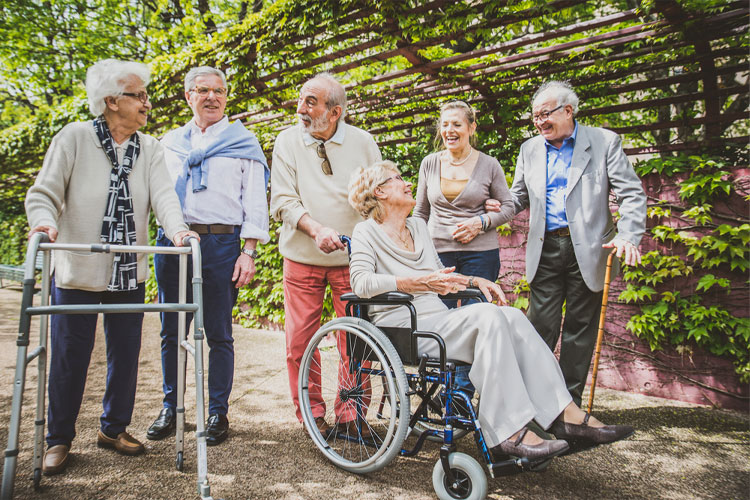
The Crucial Role of Walking Aids in the Healing Journey
The road to recovery after an injury, surgery, or medical procedure can be both challenging and rewarding. During this journey, walking aids emerge as invaluable companions, aiding individuals in regaining their independence, mobility, and confidence. From the versatile rollators to the steadfast standard walkers, each walking aid plays a unique role in supporting recovery and helping individuals get back on their feet. In this blog post, we’ll explore the significance of various walking aids and accessories, highlighting the Role of Walking Aids and how they contribute to the healing process.
1. Rolling Walkers (Rollators): Enhancing Mobility with Stability:
Rollators, often referred to as rolling walkers, are a testament to modern design and functionality. These walking aids combine mobility with stability, featuring four wheels, a comfortable seat, and handlebars. The importance of rollators lies in their ability to provide support during walks, while also offering a convenient place to rest if needed. For individuals recovering from surgeries or dealing with balance issues, rollators offer a secure and versatile solution that promotes gradual progress and freedom of movement.
2. Standard Walkers: Steadfast Support on the Path to Recovery:
Standard walkers are the quintessential walking aid, recognized for their robust structure and reliable assistance. Their simplistic design, consisting of four legs and handles, offers users the stability they need as they regain their strength and coordination. These aids are especially crucial for those who require strong support, as they facilitate a slow and steady approach to walking again. Standard walkers empower individuals to take confident steps, facilitating a gradual transition towards improved mobility.
3. Knee Walkers: Easing Mobility with Lower Limb Injuries:
For those recovering from injuries or surgeries that affect the lower limbs, knee walkers emerge as an innovative solution. These mobility aids provide an alternative to crutches and standard walkers by allowing users to rest the injured leg on a padded platform while propelling themselves with the other leg. The significance of knee walkers lies in their ability to enhance mobility without putting unnecessary strain on the recovering limb, making them an ideal choice for those seeking comfort and flexibility during their recovery journey.
4. Walking Canes: A Time-Tested Companion for Stability:
Walking canes are perhaps the most recognizable of walking aids, known for their simplicity and functionality. These aids offer stability and balance support, particularly for individuals dealing with minor injuries or mobility challenges. Walking canes also come in various styles, such as single-point canes, quad canes, and offset canes, each designed to cater to different needs. The importance of walking canes rests in their role as a versatile accessory that empowers users to navigate their surroundings with greater confidence.
5. Crutches: Elevating Recovery with Upper Body Support:
Crutches have long been associated with injury recovery, offering essential upper body support for individuals with injuries that affect the lower limbs. These aids enable users to maintain mobility while keeping weight off the injured leg or foot. By distributing the weight across the arms and shoulders, crutches play a pivotal role in facilitating the healing process and preventing further strain on the recovering area.
6. Walking Aid Accessories: Completing the Healing Puzzle:
Beyond the core walking aids, a range of accessories further enhances the recovery experience. From attachable bags and baskets for carrying personal items to adjustable handles and ergonomic grips, these accessories tailor the walking aids to individual needs. The significance of these accessories lies in their ability to enhance comfort, convenience, and usability, allowing users to focus on their recovery journey without unnecessary challenges.
The Role of Walking Aids
Walking aids are not merely tools; they are symbols of empowerment and progress during the recovery process. Whether it’s the steady support of a standard walker, the convenience of a rollator, or the adaptability of knee walkers, these aids play a pivotal role in helping individuals regain their independence and mobility. With the right walking aid and accessories, the journey towards healing becomes not only manageable but also an opportunity for personal growth and triumph over adversity. Embrace the assistance and the Role of Walking Aids and pave the way for a stronger, more confident stride toward a healthier tomorrow.
Post Views: 7
Tags: Knee Walkers, Rolling Walkers, Standard Walkers, Walking Aid Accessories, walking aids, Walking Canes
Recent Posts
 Regain Your Freedom with the Right Mobility Equipment
Regain Your Freedom with the Right Mobility Equipment Discover the Freedom of Mobility with the Golden Buzzaround EX
Discover the Freedom of Mobility with the Golden Buzzaround EX The Jazzy® Elite ES Portable Front Wheel Drive Power Wheelchair
The Jazzy® Elite ES Portable Front Wheel Drive Power Wheelchair Empowering Independence of Individuals with Disabilities With Power Wheelchairs
Empowering Independence of Individuals with Disabilities With Power Wheelchairs A Lightweight Marvel: The Gypsy Folding 4-Wheel Scooter
A Lightweight Marvel: The Gypsy Folding 4-Wheel Scooter














